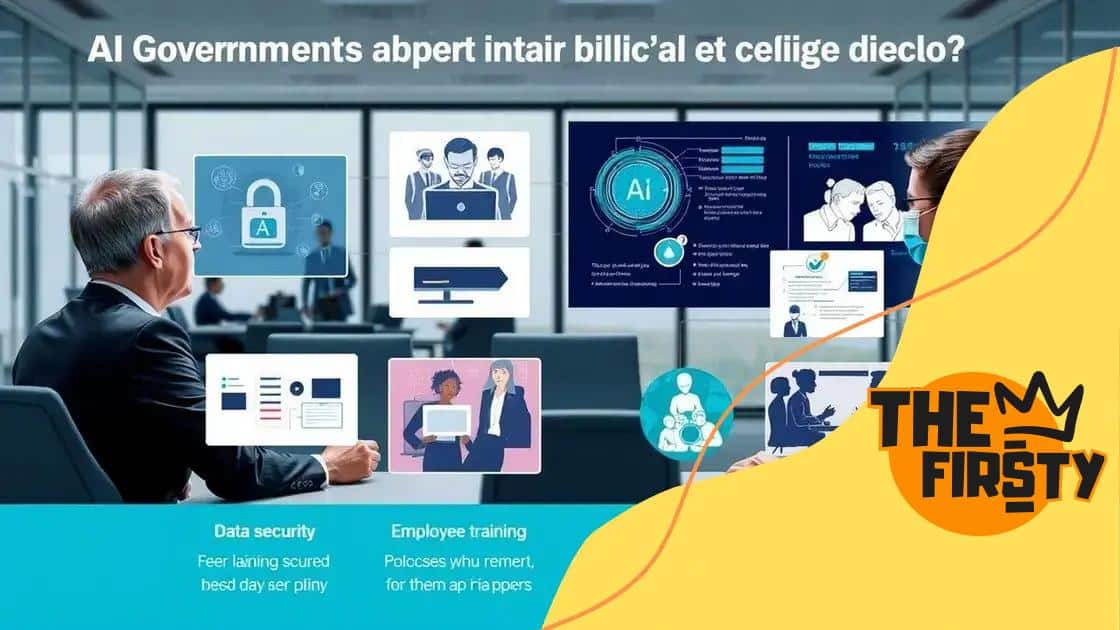How AI is optimizing public sector operations

Anúncios
AI is optimizing public sector operations by streamlining services, enhancing data-driven decision-making, and enabling predictive analytics, while addressing challenges like data privacy and skill gaps to drive efficiency and improve citizen engagement.
How AI is optimizing public sector operations is changing the way governments function. Imagine a world where processes are smoother, decisions are data-driven, and citizens feel more engaged. Curious about how this transformation is unfolding? Let’s dive in.
Anúncios
Benefits of AI in government services
The integration of AI in government services brings remarkable advantages that enhance efficiency and improve public engagement. With technology advancing rapidly, it is essential to understand how these benefits manifest in practice.
Streamlined Operations
One of the most significant advantages of AI is its ability to streamline operations. Government agencies are often burdened with bureaucratic processes that slow down service delivery. By incorporating AI, these processes can be automated, leading to faster decision-making and reduced wait times for citizens.
Improved Data Analysis
AI can analyze vast amounts of data quickly, enabling better insights for policymakers. This data-driven approach helps in identifying trends, predicting future needs, and allocating resources more effectively. A few key points about improved data analysis include:
Anúncios
- Predictive analytics helps forecast service demands.
- Enhanced accuracy in data processing minimizes errors.
- Data transparency fosters trust between the government and citizens.
Additionally, with AI, government services can become more responsive. For instance, chatbots can handle common inquiries, freeing up human resources for complex issues that require personal attention. This leads to an overall better experience for the public.
Furthermore, the implementation of AI can reduce costs for government operations. Automation minimizes the need for extensive staff in repetitive tasks, allowing for budget reallocation towards more pressing community needs. This is especially vital in times of financial scrutiny.
Enhanced Public Engagement
Use of AI tools facilitates better communication with the public. Through personalized online services, citizens can receive tailored information relevant to their needs. For example, governmental portals can utilize AI to present information based on user profiles.
Moreover, these technologies can also assist in problem-solving. Using feedback loops powered by AI, agencies can quickly adapt to the evolving needs of the community. This allows for a proactive rather than reactive approach, overall enhancing the citizen experience.
AI applications in public administration
The use of AI applications in public administration is transforming how government agencies operate. These technologies are enhancing efficiency, improving decision-making, and delivering better services to the public.
Automating Routine Tasks
One key application of AI in public administration is the automation of routine tasks. By adopting AI, governments can streamline processes like data entry and document management. This automation reduces human error and frees up personnel to focus on more complex issues that require attention.
- Chatbots assist citizens by answering common queries.
- Robotic process automation eliminates repetitive administrative tasks.
- AI-driven systems can identify and flag anomalies in reports quickly.
Additionally, automating these processes can lead to significant cost savings, allowing agencies to reallocate resources more effectively.
Data-Driven Decision Making
The ability of AI to analyze vast amounts of data enables government bodies to make informed decisions. With predictive analytics, they can forecast trends and allocate resources efficiently. Utilizing data smartly supports better planning and faster response times to societal needs.
Furthermore, AI offers the capability to tailor services to the community’s needs. Analyzing public feedback provides insights that aid in improving service delivery and addressing local concerns.
Another benefit of AI applications is their ability to enhance transparency. By using AI to monitor processes, agencies can provide real-time updates to citizens, fostering trust and accountability in public services.
AI tools, including geographic information systems (GIS), are increasingly used for urban planning and resource management. For instance, GIS paired with AI can identify optimal locations for new infrastructure or services based on real-time data.
Challenges of implementing AI in the public sector

Implementing AI in the public sector presents several challenges that can hinder progress. Understanding these obstacles is crucial in order to maximize the benefits AI can bring to government operations.
Data Privacy Concerns
One significant challenge involves data privacy. Governments handle sensitive information about citizens, and integrating AI solutions must ensure that this data remains secure. Public trust can be compromised if citizens feel their information is at risk. The focus on robust data protection regulations is essential.
- Compliance with strict data protection laws is necessary.
- Transparency in how data is used fosters public trust.
- Implementing encryption and cybersecurity measures is vital.
Additionally, organizations must navigate the complexities of sharing data across departments while ensuring compliance with privacy standards.
Skill Gaps in the Workforce
Another barrier to effective AI implementation is the skill gap within the workforce. Many government employees may lack the necessary technical expertise to work alongside advanced technologies. To overcome this, agencies need to invest in training and education programs.
By enhancing skills, public sector workers can better understand and utilize AI tools. Encouraging a culture of continuous learning will create a more adaptive workforce, ready to embrace innovations.
Moreover, collaboration with educational institutions can provide access to talent equipped with the necessary skills to drive AI projects forward.
Resistance to Change
Resistance to change is often a significant challenge when adopting new technologies. Employees in the public sector may be hesitant to embrace AI, fearing job displacement or uncertain job roles. Effective change management strategies are necessary to address these concerns.
Communicating the benefits of AI clearly can help alleviate fears. By showcasing success stories and positive outcomes from other sectors, agencies can encourage a more open mindset. Regular feedback from employees can also make them feel more involved in the implementation process.
Case studies of successful AI integration
Exploring case studies of successful AI integration in the public sector can provide valuable insights. These examples highlight how various agencies effectively utilize technology to improve services and operations.
Case Study 1: Predictive Policing
One notable case is predictive policing used by several police departments. By analyzing crime data, agencies can identify hot spots where crimes are likely to occur. This proactive approach helps law enforcement allocate resources more efficiently.
- Police departments using AI algorithms reported a decrease in crime rates.
- Officers can focus on areas with the highest need, enhancing community safety.
- Data-driven strategies foster better relationships between police and communities.
This example showcases how AI can be applied to enhance public safety while utilizing fewer resources.
Case Study 2: Smart Waste Management
Another case study involves smart waste management systems implemented in major cities. These systems use sensors in trash bins to monitor fill levels and optimize collection routes.
The result is a significant reduction in collection costs and improved efficiency. The benefits include:
- Less fuel consumption due to optimized routes.
- Reduced greenhouse gas emissions, promoting sustainability.
- Increased satisfaction among citizens due to timely waste collection.
Here, AI leverages data to create smarter city management solutions.
Case Study 3: Healthcare Innovations
In the healthcare sector, AI applications are making strides too. For instance, some hospitals use AI for patient diagnosis and management.
By analyzing medical data and patient records, these systems can offer personalized treatment recommendations. Benefits seen in this field include:
- Improved patient outcomes and faster diagnosis.
- Efficient use of healthcare resources and staff time.
- Enhanced patient engagement through tailored health solutions.
This illustrates the power of AI to revolutionize healthcare delivery.
Future trends in AI for government operations
The future of AI in government operations looks promising, with new trends emerging that can significantly enhance public services. One of the key advancements is the use of AI for predictive analytics. This technology will allow governments to forecast societal needs more effectively.
Increased Automation of Services
As technology progresses, more government services will become automated. This will not only speed up processes but will also reduce costs. Citizens can expect to interact with AI systems for various tasks, from renewing licenses to accessing public records.
- AI chatbots will handle many routine queries.
- Online services will become more user-friendly and efficient.
- Automated systems will ensure quicker turnaround times for applications.
This trend enhances convenience and allows human employees to focus on more complex issues that require critical thinking.
Integration of AI with IoT
Another important trend is the integration of AI with the Internet of Things (IoT). Smart devices collecting real-time data can be analyzed to improve decision-making across various departments. For instance, smart sensors in traffic management systems can optimize traffic flow based on live data.
This technology integration will lead to smarter cities. Data-driven decisions can improve everything from transportation to public safety.
The use of AI will also empower emergency services by predicting incidents based on historical data and patterns. This proactive approach can save lives and enhance community safety.
Focus on Ethical AI Use
As AI becomes more prevalent, the focus on ethical AI use will grow. Governments will need to establish clear guidelines that prioritize transparency and accountability. This includes addressing data privacy concerns and ensuring fair treatment for all citizens.
Furthermore, involving citizens in discussions about their data will foster trust and acceptance. Public engagement will be crucial as new systems are implemented.
FAQ – Frequently Asked Questions About AI in Government Operations
How does AI improve efficiency in government services?
AI streamlines processes, reducing administrative bottlenecks and speeding up service delivery, which in turn enhances overall operational efficiency.
What are the main challenges of implementing AI in public sector?
Key challenges include data privacy concerns, skill gaps among employees, resistance to change, and ensuring ethical use of AI technologies.
How can predictive analytics benefit government agencies?
Predictive analytics helps agencies forecast public needs, allowing for better resource allocation and more effective planning of services.
What role does citizen engagement play in AI implementation?
Engaging citizens in discussions about data use and AI applications fosters trust and acceptance, making the implementation smoother and more effective.





